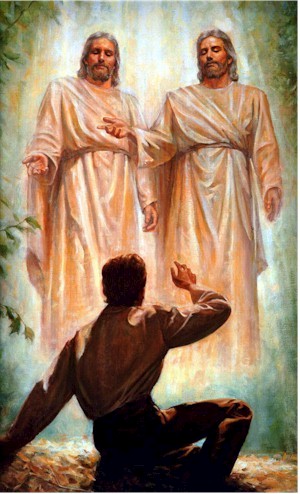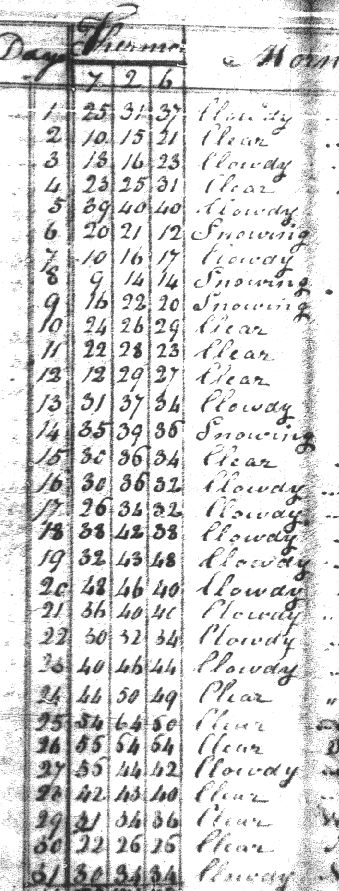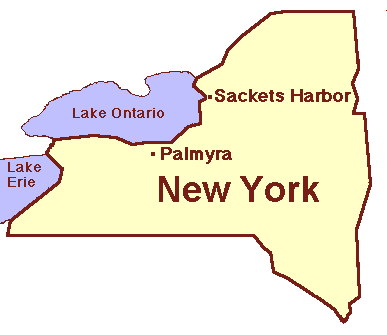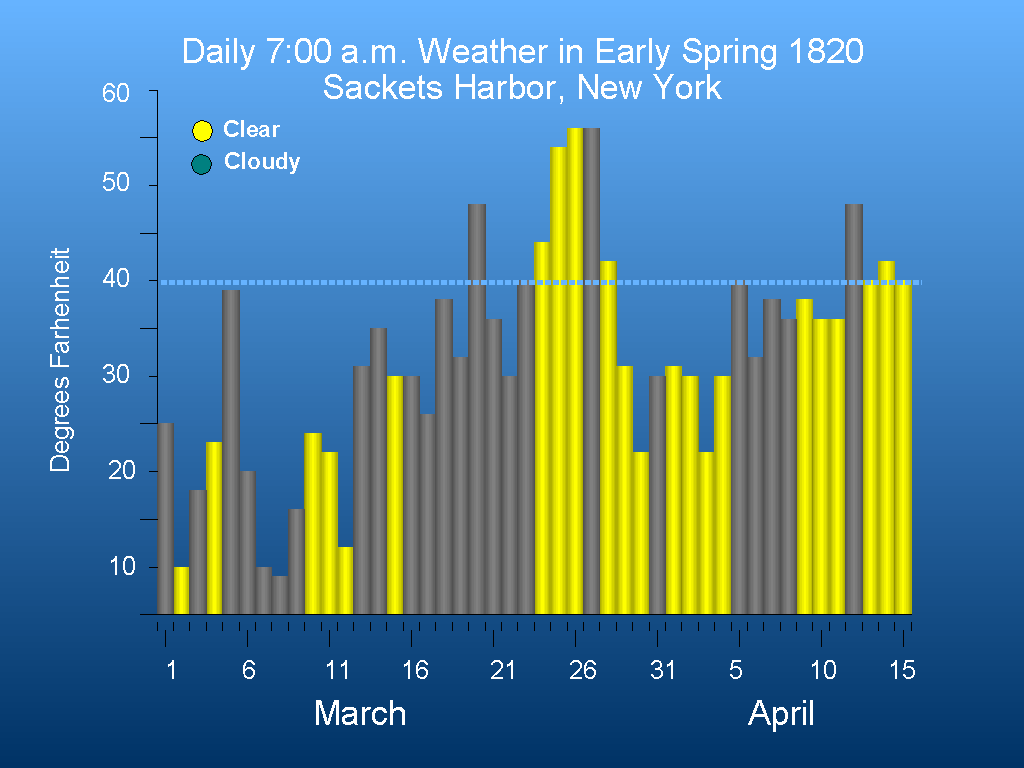
of the First Vision?
by John C. Lefgren and John P. Pratt
Reprinted from Meridian Magazine (9 Oct 2002)
©2002 by John C. Lefgren and John P. Pratt. All rights Reserved.
Two researchers working independently have come up with evidence pointing toward a date for the First Vision. Detailed weather reports coupled with maple sugar production cycles point to the compelling possibility.
 |
What is the most important date in Church history? There have been days on which some very important visitors have come. John the Baptist, as well as Peter, James and John all came to restore the priesthood. The Savior, Moses, Elias and Elijah all came on the same Easter Sunday in 1836 to restore important priesthood keys, and that day has been shown to have important calendrical significance.[1] But there was one day on which Heavenly Father himself appeared to man in the latter-days. Has there been a more important day in LDS Church history than the day of the First Vision?
In the October 1998 General Conference President Gordon B. Hinckley stated:
Our entire case as members of The Church of Jesus Christ of Latter-day Saints rests on the validity of this glorious First Vision. It was the parting of the curtain to open this, the dispensation of the fulness of times. Nothing on which we base our doctrine, nothing we teach, nothing we live by is of greater importance than this initial declaration. I submit that if Joseph Smith talked with God the Father and His Beloved Son, then all else of which he spoke is true. This is the hinge on which turns the gate that leads to the path of salvation and eternal life.[2]
The First Vision is fundamental to our religion, but what was the date on which it occurred? All that we have known about the date is that it "was on the morning of a beautiful, clear day, early in the spring" of 1820 (JSH 1:14). It has been assumed that this brief description could only be used to narrow down the date to have been within the period of late March to early April, with a Sunday being the most likely day on which a farm boy would have been able to actually go to the woods to pray.[3]
 |
Let us now attempt to identify the precise day of the Prophet Joseph Smith's First Vision. My approach is divided into two parts. First, let us make a selection of all plausible days in early spring which are identified from original 1820 weather records. Second, from the set of possible days, let us consider maple sugar production, which leads to identifying Sunday, March 26, 1820, as by far the most likely day for the First Vision to have occurred.
 |
"Morning" is a time after sunrise and before midday. This means that I will examine weather conditions which are reported for the morning.
"Beautiful" is an indication of a moderate temperature and no strong wind. I propose to look for mornings when the temperature is higher than 40° Fahrenheit with no strong wind.
"Clear" relates to the sky. In the mornings of the possible days there are no clouds, no snow, no sleet, and no rain.
"Spring" in North America is March, April, and May. For my examination, I propose that "in early spring" means a time which is after March 1st and before April 15th.
"Of eighteen hundred and twenty" means a day in the year 1820.
 |
In 1820 Dr. W. Wheaton was an officer and surgeon who was stationed with the United States Second Infantry at Madison Barracks in Sackets Harbor. He was located on a bay where the Black River flows into Lake Ontario, about eighty miles from Palmyra. Sackets Harbor and Palmyra are generally in the same weather system which is influenced and homogenized by Lake Ontario (see map).
At the time of Dr. Wheaton's assignment, the U.S. Surgeon General required medical officers to keep weather diaries. At Madison Barracks in 1820 Dr. Wheaton observed and recorded temperatures and weather conditions for each day at 7:00 a.m., 2:00 p.m., and 6:00 p.m. At the end of each month he filed his weather reports to the Office of the Surgeon General, Washington, D.C.
In 1953 the United States Weather Bureau collected climatological records and asked the National Archives and Records Administration to microfilm weather diaries. As a part of this effort, Dr. Wheaton's original 1820 weather diaries from Madison Barracks were included.[6] This record is the source to determine daily weather conditions and to select a set of possible days for the First Vision. The record is included in full in the notes at the end of this article,[7] with the column for the temperatures and morning weather shown in the accompanying reproductions of the microfilm image. The weather for early spring is summarized in Figure 1, which shows the 7 a.m. temperatures as well as whether the weather was clear (yellow) or cloudy/rainy/snowy (grey).
 |
March in 1820 came in like a lion. During the first two weeks of March there were five snow days for a total accumulation of 23 inches. During these two weeks there were only three of forty-two temperature readings above freezing. It seems appropriate to exclude the first half of March from any consideration for the First Vision. There was an increase in the average temperature during the third week of March with daily readings above freezing. Nevertheless, the weather was mostly cloudy and at no time in the early morning was the temperature above freezing. Beginning on March 22 there is a break in the weather with rising temperatures. Friday March 24 the weather is clear and the morning temperature is above 40°. This day is the first day in the set of possible days for the First Vision. Saturday March 25 is also clear and warm and is the second day in the set of possible days. Sunday morning March 26 is clear with a temperature of 56°, the highest of any day that early spring. This day is the last of three consecutive clear days and is included in the set of possible days. The 2 p.m. temperature for both March 25 and 26 was 64°, so they were both "beautiful days" that might stand out in young Joseph's memory has having been unusually pleasant. Monday morning March 27 the weather becomes cloudy and the temperature begins to drop. During the last four days of March average temperature readings decline and during the first week of April there is snow, sleet and rain. On Thursday April 13 the ice breaks up on Lake Ontario and by Saturday April 15 the weather is clear with morning readings above forty degrees. This day is too late in the spring to be included in the set of possible days.
Now let us turn to a brief overview of how maple syrup is produced, which will indicate that the first two of those days would most likely have been long, arduous work days producing maple syrup. Moreover, that same cycle indicates that there would have been no more sap to gather nor process on Sunday, March 26, leaving it the sole and ideal candidate to have been the date of the First Vision.
| "...we commenced making maple sugar of which we averaged one thousand pounds per year." |
| — Lucy Mack Smith |
 |
 |
In an effort to understand the pump effect of a maple tree's negative and positive pressures, scientists measure the dissolution rate of carbon dioxide. When temperatures are below freezing, carbon dioxide has a high dissolution and causes negative pressure. When temperatures are above freezing the dissolution rate falls releasing gas into the sap which produces positive pressure. Sometimes the release of carbon dioxide is so quick that the sap becomes a carbonated "spring tonic". (It is pressurized carbon dioxide which is used to carbonate soft drinks.) This cycle of freezing and thawing temperatures is required for the sap to continue its flow. If temperatures stay above freezing for more than thirty hours, positive pressures fall as the sapwood literally runs out of gas. When this happens farmers are happy to take a break.
 |
Sugar makers in 1820 gathered maple sap in wooden buckets. They boiled the sap in a series of iron kettles which hung over an open fire. At one end, where the fire was highest, water boiled off. As the sap thickened into syrup they ladled it into the second kettle, where the fire was lower, and added fresh sap to the first kettle. In this way, they removed the water without burning the sugar. In the last kettle they stirred liquid sugar until it crystallized and then poured it into wooden molds to form blocks. The early settlers considered maple sugar a wonder of the New World.
 |
 |
In preparation for the final draft of this article and to independently verify that scenario, on October 5, 2002 I traveled to the Joseph Smith Birthplace Memorial in Vermont. On that day I arranged to meet John and Shirley Pease as well as Bruce Johnson. These people come from families who have been involved in maple sugaring for as many as seven generations. They have first-hand experience with the effects temperature and weather have on sugar production. Each spring for the last fifty years these New Englanders have "sugared" and they know the intense effort required to collect and to boil sap. I presented to them copies of the March and April 1820 weather diaries and I asked them to describe what the Smith Family would have done to make one thousand pounds of maple sugar. Their review of the weather diaries identified the first "run" as beginning on Sunday, March 5. They estimated that the "run" lasted one day and produced less than one fourth of the season's sugar. The second "run" started on Monday, March 13, and lasted for two or three days. This "run" produced more than one fourth of the season's sugar. It was clear to them that the big "run" started on Saturday, March 18 and with sap running through Friday, March 24. They said that during this "run" the Smith Family would have kept boiling fires for twenty-four hours a day, through Saturday, and that they would have produced about half of the season's sugar. They also said that some members of the family would have worked as much as twenty hours per day as they tried to keep pace with the flow of the sap, so that it would not go sour. They claimed that no other harvest or agricultural activity is as intense and demanding as maple sugaring. Thus they verified the conclusion in detail.
One note from one of Joseph's several accounts of the First Vision implies that he had indeed been cutting timber on the day prior. The editor of the Pittsburg Gazette visited Nauvoo in 1843 and interviewed the Prophet. His rendition of what the Prophet said included the following:
"I immediately went out into the woods where my father had a clearing, and went to the stump where I had stuck my axe when I had quit work, and I kneeled down, and prayed, saying, O Lord, what Church shall I join?"[10]If that account is accurate, then it would seem to be both an indication that the axe had been left there on the previous day, and that he had been clearing trees with it. Those trees would have been used as the firewood needed to boil down the sugar.
| March | 7 | 2 | 6 | Morning | Evening | General Remarks | |
| Wed | 1 | 25 | 31 | 37 | Cloudy - N | Cloudy - W | |
| Thu | 2 | 10 | 15 | 21 | Clear - W | Clear - W | |
| Fri | 3 | 18 | 16 | 23 | Cloudy - N | Snowing - SW | |
| Sat | 4 | 23 | 25 | 31 | Clear - NW | Clear - W | Some Snow last night - 3 inches |
| Sun | 5 | 39 | 40 | 40 | Cloudy - S | Cloudy - S | |
| Mon | 6 | 20 | 21 | 12 | Snowing - N | Cloudy - W | Snow last night - 6 inches |
| Tue | 7 | 7 | 16 | 17 | Cloudy - W | Snowing - N | |
| Wed | 8 | 9 | 14 | 14 | Snowing - N | Snowing - N | Heavy fall of snow - 16 inches |
| Thu | 9 | 16 | 22 | 20 | Snowing - N | Hail - N | |
| Fri | 10 | 24 | 26 | 29 | Clear - N | Clear - W | Snow continues until this morning |
| Sat | 11 | 22 | 28 | 23 | Clear - N | Clear - N | |
| Sun | 12 | 12 | 29 | 27 | Clear - N | Cloudy - N | |
| Mon | 13 | 31 | 37 | 34 | Cloudy - N | Cloudy - NW | |
| Tue | 14 | 35 | 39 | 35 | Snowing - NE | Snowing - N | This night high winds with snow |
| Wed | 15 | 30 | 36 | 34 | Clear - NW | Cloudy - WNW | |
| Thu | 16 | 30 | 35 | 32 | Cloudy - WNW | Cloudy - NW | |
| Fri | 17 | 26 | 34 | 32 | Cloudy - NE | Clear - NW | |
| Sat | 18 | 38 | 42 | 38 | Cloudy - N | Clear - WNW | |
| Sun | 19 | 32 | 43 | 48 | Cloudy - NE | Clear - SW | Last night high winds from S and SW |
| Mon | 20 | 48 | 46 | 40 | Cloudy - SW | Snowing - NE | Last night high winds from NW |
| Tue | 21 | 36 | 40 | 41 | Cloudy - SW | Clear - NW | |
| Wed | 22 | 30 | 32 | 34 | Cloudy - S | Clear - NW | |
| Thu | 23 | 40 | 46 | 44 | Cloudy - NNE | Clear - SW | Pleasant night with moon light |
| Fri | 24 | 44 | 50 | 49 | Clear - NE | Clear - SW | |
| Sat | 25 | 54 | 64 | 50 | Clear - SSW | Clear - S | |
| Sun | 26 | 55 | 64 | 64 | Clear - SSW | Clear - SW | |
| Mon | 27 | 55 | 44 | 42 | Cloudy - W | Clear - W&NW high | High winds this night from W & NW |
| Tue | 28 | 42 | 45 | 40 | Clear - W | Clear - NW | |
| Wed | 29 | 31 | 34 | 36 | Clear - W | Cloudy - | |
| Thu | 30 | 22 | 26 | 25 | Clear - NW | Clear | |
| Fri | 31 | 30 | 34 | 34 | Snowing - NW | Snowing - NE | |
| April | 7 | 2 | 6 | Morning | Evening | General Remarks | |
| Sat | 1 | 31 | 32 | 30 | Clear - NW 5 | Cloudy - NW | High winds |
| Sun | 2 | 30 | 32 | 23 | Clear - NNW | Cloudy - NW | |
| Mon | 3 | 22 | 32 | 30 | Clear - NE | Clear - WSW | High winds from W and NW |
| Tue | 4 | 30 | 40 | 40 | Clear - NE | Clear - WSW | |
| Wed | 5 | 40 | 49 | 49 | Cloudy - ESE 6 | Cloudy - SSE | Snow and rain this evening |
| Thu | 6 | 32 | 33 | 36 | Cloudy - NE | Cloudy - W | |
| Fri | 7 | 38 | 39 | 36 | Cloudy - SE | Snowing - ENE | Snow and sleet this evening |
| Sat | 8 | 36 | 33 | 38 | Cloudy - ENE | Cloudy - W | |
| Sun | 9 | 32 | 40 | 38 | Clear - NE | Clear - W | |
| Mon | 10 | 36 | 38 | 37 | Clear .. NW | Clear - NW | High winds |
| Tue | 11 | 36 | 38 | 37 | Clear - WSW 6 | Clear - SW High | Pleasant evenings |
| Wed | 12 | 48 | 52 | 56 | Cloudy - SW | Clear - SW High | |
| Thu | 13 | 40 | 44 | 44 | Clear - W | Clear - SW High | This day the ice in the lake is broken up |
| Fri | 14 | 42 | 48 | 46 | Clear - N | Clear - SSW Pleasant | |
| Sat | 15 | 40 | 58 | 57 | Clear - N | Clear - W | Fine pleasant evening |